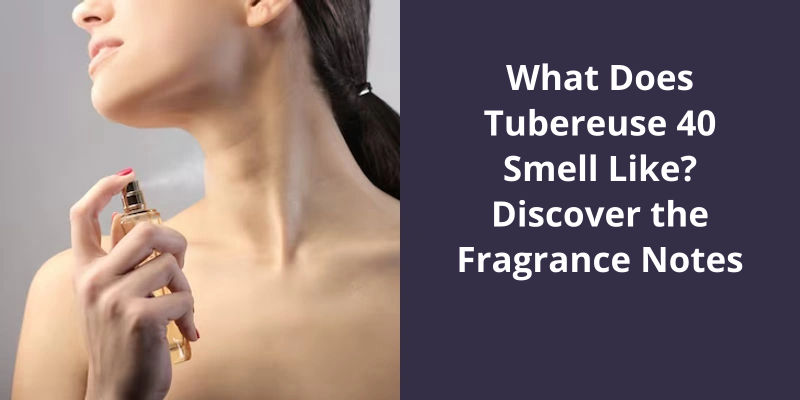Tubereuse 40 is a captivating fragrance that carries the enticing aroma of Tuberose with the freshness of citrus. In this captivating scent, you’ll first notice the dominant note of Tuberose, a rich, heady, slightly sweet and exotic scent that is often associated with luxury and passion. Following the white floral heart notes, there are light citrus notes that balance the floral depth with a delicate sharpness, lending a refreshing and breezy appeal. The depth of the fragrance is brought by warm and earthy notes of cedar and amber, creating a perfect balance of freshness and warmth. Despite its complex blend of notes, Tubereuse 40 manages to remain surprisingly light and airy, making it a uniquely versatile fragrance.

Does Tuberose Smell Like Bubblegum?
The floral version of tuberose is often used in perfumery as a base note or heart note, adding depth and richness to floral or oriental fragrances. It’s a heady quality that can be overpowering in large doses, but in the right proportion, it can be a sensual, exotic addition to any composition. The floral nuances of tuberose are complex and can range from creamy to spicy, with hints of almond, coconut, and even buttered toast.
The sweet version of tuberose, on the other hand, can be a bit more divisive. Some people will find it enchanting, while others may find it too bubblegum-like or artificial. The grape-y aspect of the scent comes from a compound called methyl anthranilate, which is also found in grape juice and other grape-flavored products. This compound gives tuberose a slight fruitiness that can be reminiscent of grape soda or grape-flavored candy. When used in small quantities, the sweet version of tuberose can add a playful, youthful quality to fragrances, but it can also be cloying if overused.
This is especially true for the floral version of the note, which can easily overwhelm if overused. If you’re looking to incorporate tuberose into your signature scent, it’s important to balance it out with other complementary notes like woods, musks, or spices. Choosing a fragrance with a moderate concentration of tuberose, such as a eau de toilette or eau de parfum, will also help ensure that the scent isn’t too overpowering.
The History and Cultural Significance of Tuberose in Fragrance and Aromatherapy.
This article explores the historical and cultural significance of tuberose in fragrance and aromatherapy. The flower has been used for centuries in many cultures for it’s fragrant and therapeutic properties, and is still a popular ingredient today in perfumes and essential oils.
The scent of tuberose carries with it a unique blend of personality traits that have the ability to evoke creativity and spontaneity in those who experience it. It’s aroma is known for stimulating the intuitive and creative side of the brain, while also embodying an extroverted, sensual and overbearing character. Tuberose has become a popular fragrance choice for those seeking an aromatic escape from the mundane, bringing a touch of extravagance to everyday life.
What Is the Personality of Tuberose Scent?
Tuberose is a fascinating scent that’s captured the attention of perfumers and enthusiasts around the world. A native of Central America, this flower emanates a strong, sweet fragrance that’s hard to ignore. It’s commonly used in perfumes, candles, and bath products due to it’s enticing aroma that stimulates the right part of the brain responsible for creativity and intuition.
When it comes to personality, tuberose is the quintessential extrovert. It’s bold and assertive aroma is instantly recognizable and hard to ignore. This scent creates a sense of intrigue and mystery, which is why many people are drawn to it.
In terms of it’s impact on the human psyche, tuberose is known to have a powerful effect on the right part of the brain. This is the part of the brain responsible for intuition, creativity, and imagination. If you’re looking for inspiration and an extroverted attitude in your life, then you may want to try using products that contain tuberose.
It’s bold, overbearing, and sensual, and it’s the power to stimulate the right part of the brain responsible for creativity and intuition.
A History of Tuberose Including It’s Origins, How It Was First Discovered and Used, and Any Cultural Significance It May Have.
- Tuberose has it’s origins in Mexico and Central America
- It was first discovered by Spanish explorers in the 16th century
- The Aztecs used tuberose in religious ceremonies and as a treatment for various illnesses
- It was later imported to Europe and became popular in France during the 17th century
- Tuberose is associated with love and sensuality, and is often used in perfumes and romantic settings
- In some cultures, tuberose is used to adorn graves and honor the dead
When it comes to fragrances, tuberose has a distinctive aroma that’s loved by many. Zara Tuberose, in particular, is a fragrance that’s known for it’s heavy citrus powdery scent. But what exactly does tuberose smell like in this fragrance, and how does it stand out from others on the market? Let’s explore further.
What Does Tuberose Smell Like Zara?
It’s a distinct floral scent that’s both sweet and intense, with a hint of spiciness that adds complexity to the fragrance. The top notes of Zara Tuberose are composed of woody, green and spicy tones, with a touch of bergamot and grapefruit that delivers a refreshing and invigorating aroma. As the fragrance develops, the heart notes of tuberose emerge, providing a rich floral scent that’s both romantic and seductive.
The fragrance has a dominant floral scent that can be a bit overwhelming initially, but as it dries down, it becomes more subtle and refined.
One of the best things about Zara Tuberose is that it’s suitable for both men and women. The fragrance is versatile and can be worn during the day or night, and it’s perfect for both casual and formal occasions. It’s also long-lasting and will continue to emit it’s lovely scent for hours after application.
It’s complexity and endurance make it a fragrance that’s both alluring and memorable, perfect for anyone who wants to leave a lasting impression.
A Guide to Identifying and Appreciating Different Fragrance Notes in Zara Tuberose
- Citrus notes: lemon, bergamot, orange
- Floral notes: tuberose, jasmine, rose, lily of the valley
- Spicy notes: cinnamon, clove, nutmeg
- Woody notes: cedar, sandalwood, patchouli
- Amber notes: vanilla, musk, benzoin
Conclusion
With it’s refreshing citrus top notes and intoxicating floral heart, this scent is the perfect balance of classic and modern. The use of woodsy and musky base notes add depth and longevity to the scent, creating a truly unforgettable experience. With it’s timeless elegance and modern flair, this fragrance is a true gem in the world of perfumery.




